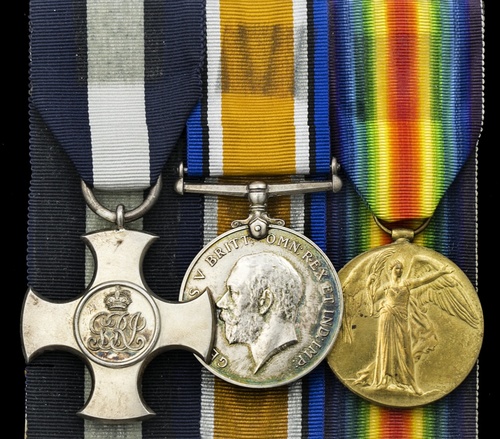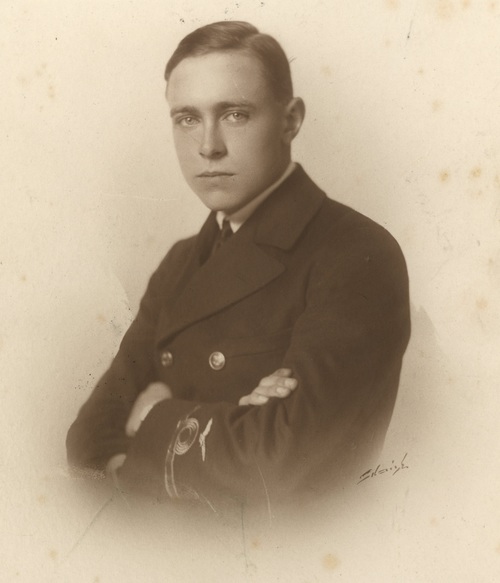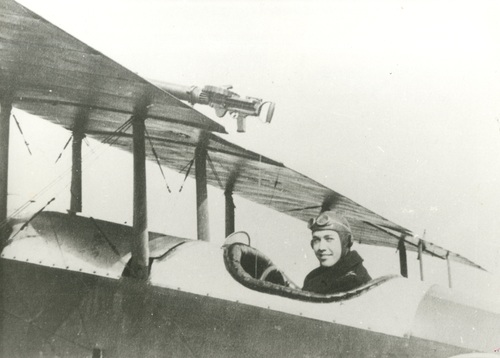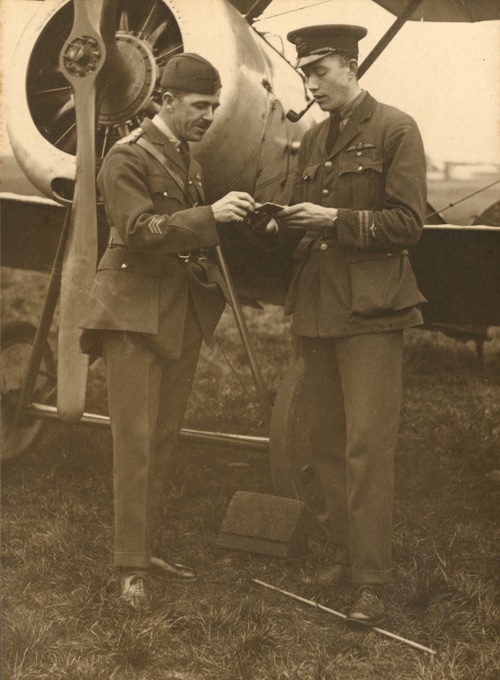Auction: 16003 - Orders, Decorations, Campaign Medals and Militaria
Lot: 11
(x) The Superb and Thoroughly Documented Great War Ace's 1918 D.S.C. Group of Three to Captain C.B. Ridley, Royal Air Force, Late Royal Naval Air Service, Credited With At Least Eleven Great War Victories Flying With No.1 Naval Squadron And No.201 Squadron, Completing Over 200 Operational Sorties. Ridley Became A Most Audacious And Courageous Pilot Completing Over 40 Air-To-Air Combat Sorties In Sopwith Triplanes And Camels, Being Awarded His D.S.C. Following Seven Victories And A Daring Trench Attack. An Early Expert Of Strafing Activities Upon The Enemy, Ridley In One Such Operation Reportedly Flying As Low As 10 Feet Which Left Them In 'Complete Panic'
a) Distinguished Service Cross, G.V.R., silver (Hallmarks for London 1917)
b) British War and Victory Medals (Capt. C.B. Ridley. R.A.F.), good very fine, mounted court-style for presentation purposes, together with the following archive:
- The recipient's Commissioning Documents as Flight Sub-Lieutenant, 25.6.1916 and as Captain, 1.4.1918
- Two portrait photographs of the recipient
- A large file with a number of original newspaper cuttings, copied photographs and documents, all pertaining to the education, career and death of the recipient
- Thirty-three copied images, some with annotations from the original photograph album of the recipient of his service throughout his service
- Copied Log Book entries, 1918-19 (Lot)
D.S.C. London Gazette 17.4.1918 Flight Lieutenant (Acting Flight Commander) Cyril Burfield Ridley, R.N.A.S.
For distinguished services as a pilot and for courage in low-flying expeditions during which he attacked enemy trenches with machine-gun fire from a height of 30 feet. On 9 March 1918, he attacked a formation of enemy scouts, selecting one which was attacking one of our machines. The enemy aircraft dived down with a quantity of smoke issuing from it, but it appeared to flatten out at 2,000 feet and disappeared in the mist. He has previously destroyed several enemy machines, and has at all times led his flight with great skill and courage.
Captain Cyril Burfield Ridley D.S.C., born at Esher, Surrey, January 1895; educated at Arundel House, Surbiton; commissioned Flight Sub-Lieutenant, Royal Naval Air Service, 25.6.1916; promoted Flight Lieutenant & Honoury Captain, Royal Air Force, 1.4.1918; killed in a flying accident, 17.5.1920 and is buried in the Cologne Southern Cemetery, Germany.
A Young Glider
During his education at Arundel House, Ridley soon became a keen member of the Aero Club, in his time becoming an accomplished builder of both gliding and powered aeroplanes. During 1910, aged only 15, Ridley built a glider with the vast wingspan of 18 feet, so successful that it was demonstrated at the Crystal Palace and Sandown Park. A cutting of Flight, dated 26.8.1911 also includes an image of 'Master C. Ridley, the boy model maker, who won the Gamage Silver Challenge Cup and Gold Medal for longest flight at this competition.'
His love for the air developed into a career, working as an Aeronautical Engineer for the Sopwith Aviation Company, during which time he also qualified as a pilot, from Hall School, Hendon, with Certificate '2427', 20.2.1916, posted to Dover and successfully completing both patrols and escort sorties.
Opening The Account
Although his initial training had been a success, the first combat victory for Ridley was not accounted for until Spring 1917, sharing an Albatros DIII over Villers Les Cagnicourt, 29.4.1917, later sharing an Albatros DV, near Messines, 17.7.1917, his first 'solo' that of a another DV following '...a very hot engagement with six enemy scouts' near Ypres, 14.8.1917. A DFW was scored over Zillibeke, 10.9.1917 with his report stating 'One two-seating observed approaching our formation over Zillibeke at 16,000 feet at 5.05pm. On being observed it immediately dived east and I fired a short burst into it, whereupon it dived vertically and turned west, eventually appearing to flatten out at 1,000 feet over Ypres. I followed it down firing continuously at it from point-blank range until my gun jammed over the enemy trenches. The E.A. was last seen going down low over the trenches with puffs of smoke emitting from its engine.'
What else that is evident from the study of the supporting documentation is that of his many 'probables'. Many inconclusive combats are noted, including in June, that of driving an enemy scout to 900 feet, strikes seen entering the fuselage and wings, 3.9.1917. A mere three days later, north of Lille, Ridley shot up an enemy kite-balloon, causing the enemy observer to make use of his parachute, Ridley noting he was lucky to clear '...very intense A.A. fire' upon his climbing from the target. A charming margin note, following that '...the balloon appeared to be hit but did not catch fire', stated only 'Balls'.
More Kills and Onto Camels
By December 1917, Ridley was promoted Flight Lieutenant and had converted to Camels, claiming an Albatros DV, which fell from the sky from 18,000 feet, near Passchendaele, 6.12.1917. He then returned home until February 1918, completing Home Defence Duties from Dover and London.
12.3.1918 brought a return to the Front and a shared kite balloon over Ypres, later confirmed as a decoy bearing a straw Observer.
His unit was thence re-named No. 201, Royal Air Force in April, adding one more kite balloon to his score, east of Boyelles, 8.4.1918. Before July 1918 and his appointment as a Flight Commander, four more kills were added, these being a Pfalz DIII, two Fokker Dr. Is and a Fokker DVII, going to earth '...completely out of control', 4.7.1918.
Against The Odds and An Unconfirmed Six
Great detail may be gleaned from the Squadron records of the wholly treacherous circumstances which Ridley found himself on a number of occasions and the exact frequency of his service. He is shown to have engaged 10 enemy scouts, 21.3.1918, having been forced to withdraw on account of his guns jamming. Between the calendar year of April 1917-18, Ridley is confirmed as having flown in excess of 200 sorties, a most intriguing mission being that shared with the South African Ace Flight Lieutenant S.M. Kinkead, engaging Gothas off Westende, 13.11.1917.
His service during the year was eventually rewarded with the D.S.C, London Gazette, 17.4.1918. One copy of his recommendation (National Archives AIR1/74/15/9/165 refers) states him with a record of 17 victories, no doubt as a result the many probables which may be attributed following his continuous and varied combat flying in those previous twelve months.
A Low Level Master
The opening of the citation states '...for courage in low-flying expeditions', suggesting that Ridley was far more than a consistent and active combat pilot. He was also a superbly proficient enemy strafer, with numerous entries providing details:
'Flight Lieutenant Ridley attempted an attack on Rechem. He fired 150 rounds from 250 feet at troops on the ground in a small town probably near Menin, being unable to find the aerodrome. He experienced very severe machine-gun and A.A. fire and flying onions. He encountered E.A. in mist and returned with his machine riddled with bullet' [13.7.1917]
'Flight Lieutenant Ridley observed bodies of troops in shell holes and trenches just in front of our advancing troops near Becelaere. He went down to within 10 feet of the ground and was much below the level of the trees at times. He dived at these batches of troops who ran from shell hole to shell hole pursued by the triplane. Our troops waved and cheered as the pilot flew over them and dived towards the enemy who were in complete panic.' [20.9.1917]
'Flight Lieutenant Ridley saw a block-house behind which were about 100 men. Some appeared to be climbing over the top or perhaps sniping our troops. He fired 150 rounds at these men and took several dives at them until too close to the ground, when he had to pull off. Apparently some of these troops were shot. Position N. of Becelaere.' [26.9.1917]
The Exceedingly Heavy RAM B8783
By July 1918, now promoted Captain, Ridley was requested to complete a test flight upon the RAM B8783. As a vastly experienced pilot in low-level missions, his report would be essential for the approval of new machines. However a report regarding the machine makes for stark reading 'Having flown this machine, I consider it very slow, exceedingly heavy on controls, and unmanageable for manoeuvring near the ground. I therefore consider it unsuitable for low-flying and ground strafing work. After I had been in the air for fifteen minutes, the engine failed, owing to a broken piston liner, and I was forced to land.’ The conclusion from the field confirms the trust in the opinion of Captain Ridley, concluding it is ‘..little doubt that this machine is unsuitable for any military purposes.'
Following the Great War, Ridley remained with the Royal Air Force being killed in a training accident. His Bristol fighter colliding mid-air with the aircraft of Flight Lieutenant J.D. de Pencier, 17.5.1920, Lindenthal, Cologne, Germany. Both men were serving with No. 12 Squadron, with the aircraft crashing from a height of approximately 450 feet (Berliner Lokal-Anzeiger, refers), their crew sustaining injuries but surviving. Ridley is buried in the Cologne Southern Cemetery, Germany.
PROVENANCE: DNW, September 2012
Subject to 5% tax on Hammer Price in addition to 20% VAT on Buyer’s Premium. For more information please view Terms and Conditions for Buyers.
Estimate
£7,500 to £9,500











